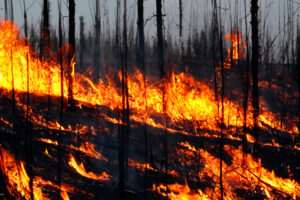 With the death toll from Maui’s wildfires rising past the 110 mark and the possibly of another 1,000 still missing, President Joseph R. Biden last week declared that a major disaster exists in the State of Hawaii and has ordered Federal aid to supplement state and local recovery efforts in the areas affected by wildfires beginning on August 8, 2023, and continuing.
With the death toll from Maui’s wildfires rising past the 110 mark and the possibly of another 1,000 still missing, President Joseph R. Biden last week declared that a major disaster exists in the State of Hawaii and has ordered Federal aid to supplement state and local recovery efforts in the areas affected by wildfires beginning on August 8, 2023, and continuing.
The U.S. Department of Housing and Urban Development (HUD) has announced a package of regulatory and administrative waivers to allow the use of HUD funding to help communities in Maui and the Island of Hawaii to accelerate their recovery. HUD’s announcement follows initial support the Department has provided to families in the wake of the fires.
“We're committed to supporting Hawaii communities. Our deepest condolences go to those who have lost loved ones. HUD is doing everything in our power to ensure that survivors of these devastating fires have a safe place to call home,” said HUD Principal Deputy Assistant Secretary for Community Planning and Development Marion McFadden. “After a disaster, priorities shift towards recovery. We are empowering local grantees to use existing resources for their most pressing needs and have enacted every flexibility within our authority."
HUD’s latest regulatory and administrative relief covers the following HUD programs: Community Development Block Grant (CDBG), HOME Investment Partnerships (HOME), Housing Trust Fund (HTF), Housing Opportunities for Persons with AIDS (HOPWA), Emergency Solutions Grant (ESG), and Continuum of Care (CoC). To expedite the use of these funds, HUD’s state and local partners can now access a waiver through a new simplified notification process.
Through this waiver package, HUD is providing flexibility by:
- Suspending the CDBG public services cap to provide additional support services related to the effects of the disaster on individuals and families–allowing funds to pay for food, water, and other emergency needs.
- Allowing new housing construction with CDBG funding in declared-disaster areas.
- Providing flexibility in HOME tenant based rental assistance requirements to reduce burden for those seeking assistance.
- Waiving the HOME local matching contribution requirements and providing greater flexibility in the entities that can expeditiously provide housing to displaced persons and repair properties damaged by the disaster.
- Extending the period of time that individuals can receive temporary assistance, including CDBG emergency grant payments and ESG rental assistance.
CoreLogic estimates that approximately 3,088 single- and multifamily residential properties with a combined reconstruction value (RCV) of $1.3 billion were reported within three preliminary wildfire perimeters on Maui.
FEMA has more than 600 personnel on the ground on Maui tasked with reaching survivors where they are, and residents now have the option to apply for federal disaster assistance at a joint Disaster Recovery Center recently opened at the University of Hawaii Maui College in Kahului, Hawaii.
President Biden and the First Lady are set to travel to Maui on Monday, August 21 to meet with first responders, survivors, as well as federal, state, and local officials, in the wake of deadly wildfires.
Below are examples of what HUD’s funding can be used for in the wake of the wildfire disaster:
- Assistance to those experiencing or are at-risk of homelessness
- Tenant-based rental assistance
- Housing rehabilitation
- Demolition of buildings
- Housing reconstruction
- Homebuyer assistance replacing disaster damaged residences
- Voluntary acquisition and relocation programs to help people move
- Infrastructure improvements
- Reconstruction or replacement of public facilities
- Small business grants and loans to cover uninsured losses
Earlier this year, HUD announced an overhaul of the agency’s disaster recovery efforts to better serve communities who face the direct impacts of weather-related disasters. HUD established the Office of Disaster Management (ODM) in the Office of the Deputy Secretary, the Office of Disaster Recovery (ODR) within the Office of Community Planning and Development, the addition of dozens of new HUD staff members to help expedite recovery processes, and the allocation of more than $3.3 billion in Community Development Block Grant-Disaster Recovery (CDBG-DR) funds.

 DSNews The homepage of the servicing industry
DSNews The homepage of the servicing industry









